Translate this page into:
Influence of some organic ligands on the adsorption of lead by agricultural soil
⁎Corresponding author.
-
Received: ,
Accepted: ,
This article was originally published by Elsevier and was migrated to Scientific Scholar after the change of Publisher.
Peer review under responsibility of King Saud University.
Abstract
The adsorption of lead onto agricultural soil in the presence of organic compounds such as, humic acid, gallic acid or phenol was studied. The study included the factors affecting the adsorption process such as contact time, pH, adsorbent dose, metal concentration and organic ligands concentration. The experimental isotherm data were found to fit both Langmuir and Freundlich isotherms. The results show that the pseudo second-order equation provides the best correlation for the adsorption process. The results indicate that both humic acid and phenol increase the adsorption of lead while gallic acid slightly decreases the adsorption.
Keywords
Adsorption
Lead
Humic acid
Gallic acid
Phenol
Soil
1 Introduction
Soil and water resources were approved to be contaminated with heavy metals, as a result of increasing industrialization and mining activities (Al-Farraj and Al-Wabel, 2006). Increasing level of heavy metals including Pb2+ in the environment represents a serious threat to human health, living resources, soil quality and ecologic systems (Nigam and Srivastava, 2003). In this respect, information regarding the mechanisms of lead adsorption/desorption in soil minerals is important as these reactions control the strength of metal–soil surface interactions (Wu et al., 2003; Al-Sewailem, 2007).
Heterogeneous soil systems that composed of both organic and inorganic constituents show different affinities toward heavy metals. In addition, heavy metals themselves exhibit varying affinities for soil surfaces. Variability in heavy metal affinity for soil sorption sites has been attributed to a given metal’s hydrolysis constant (pKH), electronegativity, Lewis acidity, charge density and solubility (Ksp) of precipitates including hydroxide and carbonate (Pardo, 2000; Sparks, 2003).
The availability of lead and other metals in soil depends on the way the metal partitions between solid phases and the soil solution. The solid–solution partitioning of heavy metals in soils depends on various soil properties including pH, texture and contents of clay, organic matter, and iron and manganese oxides (Rieuwerts et al., 1998a,b). The previous studies have indicated that pH is an important factor in Pb adsorption onto soil constituents. Increasing solution pH leads to a rapid increase in net negative surface charge and thus increases soil’s affinity for metal ions. (Wu et al., 2003).
The presence of soil organic matter, basically humic substances, is important for speciation and mobility of pollutants in the environment; because of its high functionality (carboxyl, hydroxyl, and amino groups), thereby they modify the retention, adsorption, migration, and bioavailability of metal ions in the natural environment.
In cases of contaminated soils, heavy metals and organic pollutants such often coexist. Phenolic compounds are priority pollutants due to their toxic and harmful effect even at low concentrations, they result from olive oil mill effluents, plant exudation, petroleum, petrochemical and coal conversion industries (Hudson, 2006).
Compared with the extensive separate studies on the sorption of heavy metals and organic chemicals onto clays, there is little information on the effect of heavy metals on the sorption of organic chemicals and vice versa (Liang-guo et al., 2007). Organic acids may increase or decrease the adsorption of heavy metal ions by soils, depending on the mechanisms of interaction among the organic acid, soil, and metal ions. Of these compounds, low molecular weight organic acids (LMWOA) are of particular importance due to their metal chelating and complexing properties for mobilization of heavy metals. Schwab et al., 2005, studied the adsorption of lead on soil in the presence of salicylate and citrate and they found that adsorption of lead to soil was slightly enhanced with increasing salicylate concentration but decreased in the presence of citrate. However, up until now, little information has been available regarding the effect of LMWOA on the adsorption of heavy metals by variable soils.
In this respect, the objective of this investigation was to study the effect of organic ligands namely, humic acid, phenol, and gallic acid on the sorption of lead onto agricultural soil.
2 Material and methods
The uncontaminated soil used in this study was collected, crushed with a mortar and pestle to break up any clumps and passed through a 2 mm sieve before use. The soil texture was analyzed by the hydrometer method (Sheldrick, 1986), and found to consist of 15% sand, 55% silt, and 30% clay. Soil pH of 8.5 was measured by using pH meter of the kind (Hanna instruments) at a soil to solution ration of 1:2.5 in bidistilled water The organic matter content (0.1%) was determined by loss on ignition method (Heiri et al., 2001). The chemical composition is determined by energy dispersive X-ray (EDX), and illustrated in Table 1:
Soil properties
Value
pH
8.50 ± 0.12 (1:2.5)
Organic matter content (%, by mass)
0.1
Soil texture
Sand: 15%
Silt : 55%
Clay 30%
Minerals
Montmorillonite, kaolinte and calcite
Al2O3
15.23%
SiO2
63.12%
K2O
5.18%
CaO
10.04%
Fe2O3
27.48%
MnO
0.62%
MgO
0.87%
2.1 Solutions preparation
All chemicals, such as phenol, gallic acid, Pb(NO3)2, NaOH, and HNO3 were of analytical reagent grade except humic acid (sigma) was used after purification. For the Pb(II) adsorption experiments, 1000 mg/L of Pb(II) was prepared by dissolving Pb(NO3)2 in distilled water, 100 mg/L phenol, gallic acid, and humic acid were prepared as stock solutions. Suitable concentrations of Pb(II), phenol, gallic acid and humic acid were prepared by dilution from the stock solution.
2.2 Batch adsorption procedure
Adsorption experiments were carried out at the desired pH value, contact time, Pb(II) concentration and soil mass level using the necessary adsorbents in a 250 mL conical flask containing 50 mL of Pb(II) solution. Initial solutions with different concentrations of Pb(II) were prepared by the proper dilution from stock 1000 mg/L standard Pb(II). The soil suspension was shaken for 1 h with a water bath thermostatic shaker. After being centrifuged, Pb(II) concentration was analyzed by atomic absorption spectroscopy (AAS). All experiments were carried out in duplicate. The adsorption % of Pb(II) was calculated as the following:
2.3 Kinetic studies
2.3.1 Time
The kinetic experiments were conducted in batch mode on soil. A 0.1 g each of soil was weighed into 60-ml plastic bottles. Fifty milligrams per liter of Pb2+ were prepared from the stock solution. Twenty milliliters of 50 mg/L of Pb2+was added to the different bottles. Based on results of pH studies, the pH of adsorbate solution was adjusted to 4.5. Samples were agitated at room temperature (25 ± 2 °C) and were removed from the shaker at different time intervals.
2.3.2 Effect of pH
A 0.1 g each of soil was weighed into 60-ml plastic bottles. Fifty milligrams per liter of metal ion solution was prepared from its stock solution. The pH of 20 ml of 200 mg/L metal ion to be investigated was adjusted to several pH values in the range of 2.0–6.0 using 0.01 M NaOH or 0.1 M HNO3 acid and was subsequently added to the different bottles containing the soil. The solutions were then agitated at room temperature (25 ± 2 °C) for 1 h. Thereafter, they were centrifuged for 15 min at 3000 rpm and then analyzed.
2.3.3 Adsorbent dose
The effect of adsorbent dose, a range of 0.025–0.2 g of soil, was used for adsorbent dose studies. Fifty milligrams per liter of Pb2+ was used for the study.
2.3.4 Initial metal ion concentration (sorption isotherm modeling)
The theoretical sorption capacity of soil can be calculated with a sorption isotherm. The Langmuir and Freundlich models were used for this study. A range of concentration from 10 to 400 mg/L at pH 4.5 for Pb2+ was used. All Pb2+ samples were agitated for 30 min. NaOH (0.01 M) and HCl (0.1 M) were used to adjust the pH of adsorbate solutions. The solution was centrifuged and analyzed.
2.3.5 Effect of organic ligands on adsorption isotherms of Pb(II)
Appropriate quantities of Pb(II) solution and organic ligand solution were added into 50-ml flasks to obtain mixed solutions containing 5 mg/L of humic acid, 50 mg/L of gallic acid or 300 mg/L of phenol and various concentrations of Pb(II) (10, 25, 50, 100, 150, 200, 300 and 400 mg/L) for adsorption isotherm experiments. The mixed solutions of 50 mg/L Pb(II) and various concentrations of humic acid, gallic acid or phenol (2, 4, 5, 10, 15, 20, 30, 40, 50 mg/L) were prepared for experiments on the effect of organic acid concentration.
Samples of 0.1 g of soil were weighed into centrifuge bottles in two replicates. Then, 20 ml of the mixed solution was added into each of the bottles. The suspensions were shaken in a constant-temperature water bath at 25 °C (±2 °C) for 2 h. The solution was separated from the solid phase by centrifugation at 3000 rpm (3380g) for 15 min. Lead in solution was determined using AAS. The adsorption of Pb(II) was calculated from the difference between the total amount added and the amount remaining in solution.
3 Results and discussion
3.1 Adsorption kinetics
Fig. 1 shows the effect of contact time on the adsorption of Pb(II) on soil which is studied within the range (5–120 min) at pH 4.5. It is clear that the rate of sorption increases sharply, then gradually to reach about 90% after 30 min, and do not change after that up to 120 min the results indicate that the sorption of Pb2+ is time dependent. It is obvious that two different slopes are present in the plot. The rapid sorption followed by slow sorption of Pb2+ by soil suggests two sorption processes; ion exchange and adsorption in the beginning, followed by a slow penetration of lead into the crystal lattice of minerals forming soil. Diffusion controlled processes are generally linear in 1/t2 plots. The plot of concentration of Pb2+ adsorbed against 1/t2 is presented in Fig.2 and shows a linear relation, in the region of low times (before equilibration). Since soil constituents are principally SiO2, Fe2O3 and Al2O3 (Table1); there exist many various adsorption/exchange sites. Therefore, the mechanisms of Pb2+ sorption may include physical and chemical adsorption and/or ion exchange (Khan et al., 1996).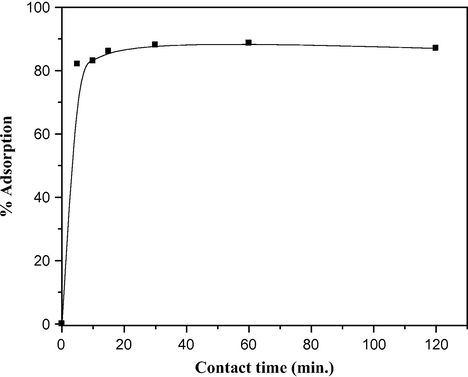
Effect of contact time on the adsorption of Pb(II) onto soil.
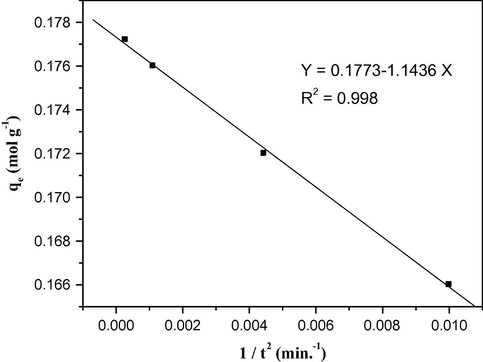
Variation of adsorbed Pb(II) with 1/t2.
In order to clarify the adsorption kinetics of Pb(II) ions onto soil, Lagergren’s pseudo-first-order and pseudo second-order kinetic models were applied to the experimental data. The linearized form of the pseudo-first-order rate equation by Lagergren is given as:
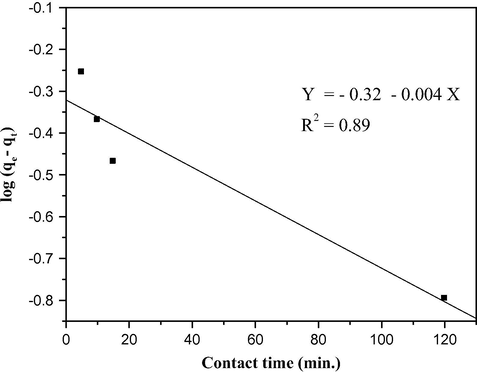
Pseudo-first-order adsorption kinetics of Pb(II) on soil.
The plots of log (qe – qt) versus t for the Lagergren-first-order model do not fit a pseudo-first-order kinetic model and the R2 value for this model is low (0.83). Experimental data were also applied to the pseudo-second order kinetic model which is given in the following form:
This model is more likely to predict the kinetic behavior of adsorption with chemical sorption being the rate controlling step. The plot of t/qt versus t (Fig.4) yields very good straight line for adsorption of Pb(II) onto soil. Table 2 lists the computed results obtained from the second-order equation. The rate constant (k2), correlation coefficients for the second-order kinetic equation was found greater than 0.999. The calculated qe values are also agree very well with the experimental data. These indicate that the adsorption system studied belongs to the second order kinetic model.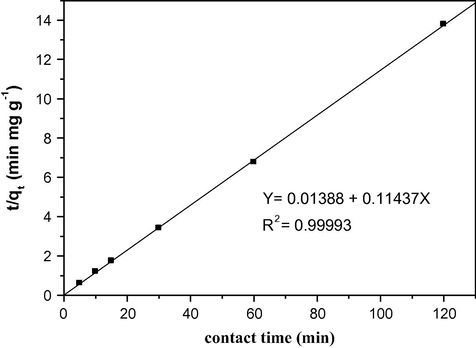
Pseudo-second-order adsorption kinetics of Pb(II) on soil.
Pseudo-first-order
Pseudo-second-order
q, exp. (mg/g)
qe (mg/g)
K1 (min−1)
R2
qe (mg/g)
K2 (g/mg min)
h (mg/g min)
R2
0.3394
8.8 × 10−3
0.8317
8.75
12.6
0.9999
8.86
3.2 Effect of pH
The effect of solution pH on the absorption of Pb(II) by the soil was investigated in the range (2.2–6.5), at 25 °C and initial lead ions concentration of 50 mg/L. The results are presented in Fig. 5 .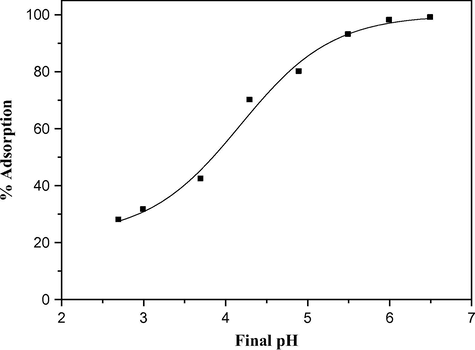
Effect of pH on Pb(II) removal by soil at initial Pb(II) concentration of 50 mg/L, soil dose = 5 g/L.
Increasing the pH value of the solution from 2.7 to 4.9 leads to an acceleration in the adsorption rate especially in the earlier stages. The influence of pH on the adsorption process of lead ions on soil can be explained through the influence of H+ ions on the complex ion formation process (Omar and Al-Itawi, 2007). The formation of complexes during the adsorption process is occurred by the interaction between the lead ions and the soil negative charged sites (SiO−) as well as the lattice hydroxyl groups (Si–OH) according to Eqs. (4) and (5):
Decreasing the pH value results in increasing the amount of H+ ions in solution. H+ ions can compete with Pb2+ ions and bind to the SiO− site of soil according to Eq. (4). As a result, the number of free SiO− sites available for Pb2+ ions to form stable complexes will decrease; therefore the adsorption rate will consequently decrease. Moreover, increasing the amount of H+ ions due to the decrease in pH will lead to shifting of the equilibrium described by Eq. (5) to the lift side leading to a decrease of the adsorption rate of lead ions.
3.3 Effect of soil weight
Adsorption % of Pb(II) on soil is studied at different weights [0.025, 0.04, 0.05, 0.1, 0.15, 0.2 g] and at initial lead concentration (50 mg/l), temperature (25 °C) and contact time (30 min). As indicated in Fig. 6, it is clear that the adsorption % increases with soil weight, and a maximum is observed at 0.2 g. As pointed out by Shukla et al., 2003, higher adsorbent amount creates particle aggregation, resulting in a decrease in the total surface area and an increase in diffusional path length both of which contribute to decrease in amount adsorbed per unit mass.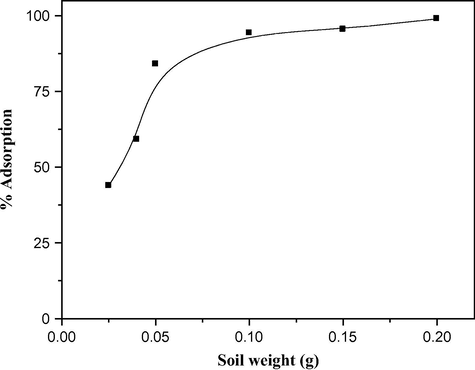
Effect of soil weight on adsorption % of Pb(II).
3.4 Effect of Pb2+ concentration
The adsorption isotherms of Pb(II) onto soil are studied using initial concentration of Pb(II) ions from 10 to 400 mg/L and adsorbent mass of 0.1 g at 25 °C. As Fig. 7 shows, the % adsorption of Pb(II) is about 98% at metal ion concentration of 10 mg/l, away from this value it decreases. When a cation is accepted by an exchange site, a cation exchange site is removed, lowering the effective cation exchange capacity, therefore, the % adsorption decreases. This decrease means that the Pb2+ included in the system, after achievement saturation (Helal, 2006).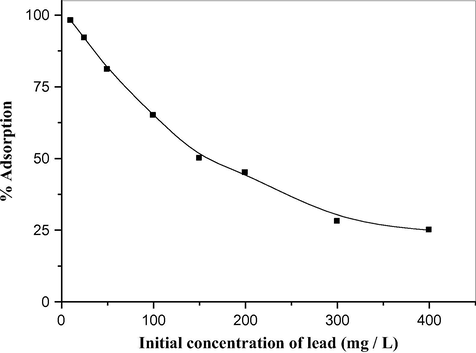
Sorption of lead ion onto soil as a function of initial concentration.
The relation between concentration of Pb2+ adsorbed and that in solution at equilibrium is indicate in Fig.8. This Langmuir-type (L-type) isotherm suggests a monolayer adsorption. The mathematical description of (L-type) adsorption isotherm is conveniently carried out by application of the Freundlich and Langmuir equations.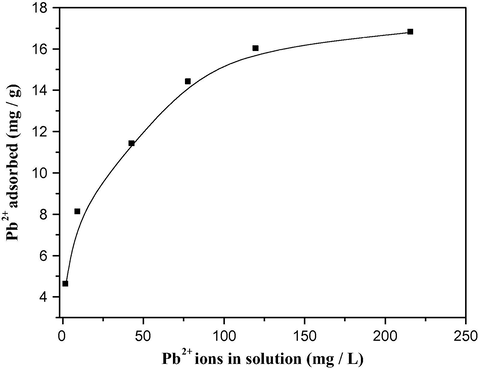
Variation of the amount of lead adsorbed with that in solution at equilibrium.
3.5 Adsorption isotherm
The equilibrium adsorption isotherms are one of the promising data to understand the mechanism of the adsorption. The adsorption equilibrium is usually described by an isotherm equation whose parameters express the surface properties and affinity of the adsorbent. Adsorption isotherms can be generated based on theoretical models where Langmuir and Freundlich models are the most commonly used ones. The Langmuir model assumes that uptake of metal ions occurs on a homogenous surface by monolayer adsorption without any interaction between adsorbed ions. The Langmuir equation may be written as:
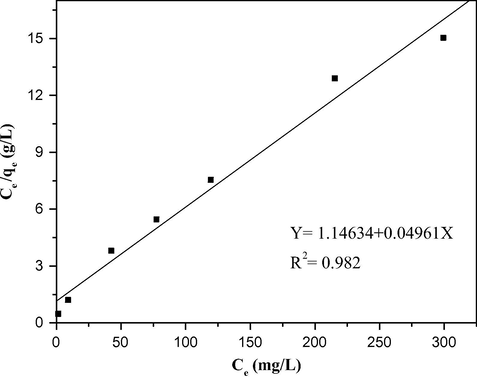
Linearized Langmiur isotherm model for Pb(II) adsorption by the soil.
The Freundlich isotherm is an empirical equation employed to describe heterogeneous systems. The linearized form of the Freundlich isotherm equation is:
Fig. 10 shows the plot of log qe against log Ce, a straight line was obtained and the constants n and Kf can be determined from the slope and intercept, respectively.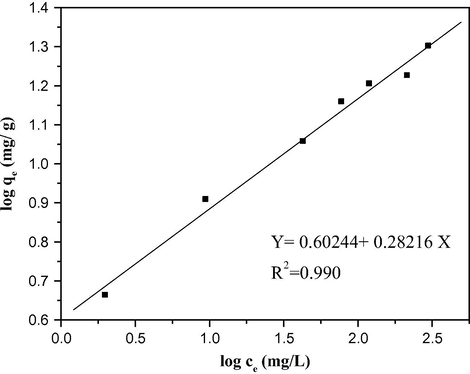
Linearized Freundlich isotherm model for Pb(II) adsorption by the soil.
Table 3 lists the values of the calculated Freundlich and Langmuir constants Kf and n.
Langmuir isotherm
Freundlich isotherm
Qo (mg/g)
b (L/mg)
R2
n
Kf (mg/g)
R2
20.157
0.0432
0.982
3.54
4.003
0.990
In general, the data obtained from the studies of adsorption fitted both models very well. However, Freundlich isotherm gave a better fitting than Langmuir isotherm did when the R2 values are compared in Table 3. In summary, isotherm-fitting yields good results with both Langmuir and Freundlich equations and this indicate that the adsorption sites were non-uniform and nonspecific in nature. It was in conformity with the existence of different types of possible adsorption sites on soil surface. The adsorption coefficients agreed well with the conditions supporting favorable adsorption.
3.6 Effect of organic ligands on the adsorption of Pb(II) by soil
Fig. 11 shows that the presence of either humic acid or phenol increases the % adsorption of Pb2+ by the soil, while it slightly decreased in case of gallic acid. The increase in case of humic acid is higher than that of phenol. As elucidated by Lai and Chen, 2001, there are three possible mechanisms for humic acid in the metal adsorption system. First, humic acid can inhibit metal adsorption forming non-adsorbable complexes with the metal. Second, humic acid competes with the metal itself for available surface sites. Third, metal adsorption can be enhanced by the presence of humic acid, due to the formation of metal–ligand complexes on adsorbent surface. Due to its high content of oxygen containing functional groups, HA is a good complexing agent for many metal ions and its binding with metal ions can improve the adsorption of heavy metal ions. This study shows that Pb(II) form a complex with humic acid, and thus cause the higher adsorption of metal ions on soil. There are two possible structures for the adsorption of metal ions and organic complex compounds on mineral surfaces. One is the S–M–HA and the other is the S–HA–M, where S represents the adsorption site on the solid surface and M is the metal ion (Liu and Gonzalez, 1999).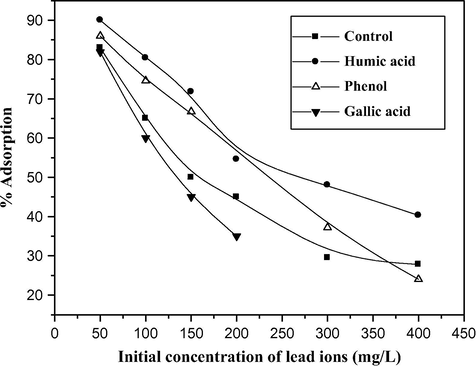
Effect of organic ligands on Pb(II) adsorption by soil at pH 4.6.
In case of phenol the adsorption of Pb(II) ions was increased by soil, phenol has an anionic character at high pH value (pKa 10) (Mabel et al., 2001) This means that phenol, under the experimental conditions exists as a molecule, but it can be adsorbed by the mineral through the formation of cation–π bond of benzene ring with Pb2+. As Pb2+ can function as a strong Lewis acid by accepting electrons, it is thus thermodynamically favorable to form a strong cation–π bond with π donors of phenol (Jensen, 1987). By comparison, this study is in contrast to other study which shows that phenol hinders the adsorption of lead on natural zeolite. This is attributed to the formation of organometallic complexes that cannot penetrate the zeolite exchange channels (Mabel et al., 2001).
However, adsorption of Pb2+ in the presence of gallic acid is slightly decreased, in our pH range 4 < pH < 9 only one of the –OH groups, i.e., GA(OH)3, could be deprotonated. As a result only one –OH group is available for metal complexation which may be due to the formation of complex with Pb2+ ion solution and this complex has low affinity to soil surface. The effect of low molecular weight organic acids (LMWOA) such as citric acid and gallic acid on phytoextraction of heavy metals such as Pb was studied by Eduardo et al. (2008), and they found that LMWOA increase the heavy metal concentration in the soil solution and cause a mobilization of Pb and Cu from oxide fractions in soil, but gallic acid solubilized a much smaller amount of metals than citric acid.
The general behavior and/or effects of metal-complexing ligands on the adsorption of metal cations by soil can be classified under the following categories (Sposito, 1984):
-
The ligand has a low affinity for the metal and for the adsorbent.
-
The ligand has a high affinity for the metal and forms a soluble complex with it, and this complex has a low affinity for the adsorbent.
-
The ligand has a high affinity for the metal and forms a soluble complex with it, and this complex has a high affinity for the adsorbent.
-
The ligand has a high affinity for the adsorbent and the adsorbed ligand has a low affinity for the metal.
-
The ligand has a high affinity for the adsorbent and the adsorbed ligand has a high affinity for the metal.
-
The metal has a high affinity for the adsorbent and the adsorbed metal has a high affinity for the ligand.
It is important to note that categories 3 and 5 result directly an enhancement of metal adsorption due to the presence of ligands, whereas category 4 may result indirectly an enhancement of metal adsorption if the adsorbed ligand causes the surface charge to become more negative. Categories 3, 5 and 6 result in an adsorbed metal–ligand complex, where adsorption of the complex can be described as a surface–metal–ligand or a surface–ligand–metal bridge (Sposito, 1984).
3.7 Effect of ligand concentration on the adsorption of Pb(II)
Fig. 12 shows that Pb(II) adsorption increases with increasing concentration of phenol. In case of humic acid, the adsorption increase up to 5 mg/L above this concentration the adsorption decrease with increasing humic acid concentration. While in case of gallic acid, the adsorption of pb2+ decreased slightly with increasing concentration of gallic acid. At low concentration of phenol, the % adsorption of Pb2+ is low but with increasing the concentration of phenol the adsorption of Pb2+ by soil increase. The increase in Pb2+ adsorption in the presence of phenol discussed as indicated by Zhang, 2010: at low concentration phenol, phenol may form cation–π bond with the accumulated cations thus prevent Pb2+ from approaching to the cations, which is exchanged with Pb2+, on the soil surface thus result in the suppression on Pb2+ sorption, while at high concentration of phenol may enhance the Pb2+ sorption via cation–π bond with Pb2+ in solution.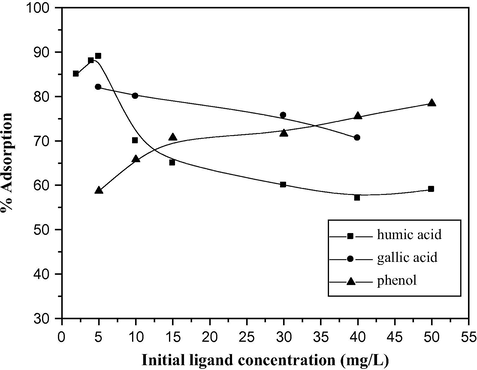
Effect of organic ligand concentration on the adsorption of Pb(II) on soil at pH 4.6.
At high concentration of humic acid, the adsorption of Pb2+ decreased this is may be due to the formation of stable soluble complexes with the highest HA concentration and for low Pb2+ initial concentrations. This resemble the behavior of Hg(II) adsorption on kalonite (Arias et al., 2004) and is in contrast to previous study which show that Pb(II) adsorption increases with increasing concentration of HA and maintains a level at last (Wang et al., 2009).
At pH 4.6, gallic acid is under gallate form (pKa = 4.1) and may form some ligands with metal cations such as Pb2+. As shown from Fig. 12 the adsorption of Pb2+ slightly decreased with increasing the concentration of gallic acid, this may be due to the formation of complex having lower affinity for soil surface.
4 Conclusions
The results obtained indicate that the adsorption system studied belongs to the second order kinetic model.
Freundlich isotherm provides a good description of the experimental data, Kf is found to be 4.00 mg/g and n is found 3.54.
The presence of humic acid enhances the sorption of Pb2+ onto soil, phenol slightly increases the sorption while gallic acid suppresses the sorption.
References
- Al-Farraj, A.S., Al-Wabel, M.I., 2006. Evaluation of Soil Pollution Around Mahad AD-Dahab Mine. Project No. 21 (Final Report).
- Characteristics of lead sorption by zeolite minerals. J. Appl. Sci.. 2007;7(13):1718-1725.
- [Google Scholar]
- Interaction of Hg(II) with kaolin–humic acid complexes. Clay Miner.. 2004;39:35-45.
- [Google Scholar]
- Phytoextraction and fractionation of heavy metals in soil after multiple applications of natural chelants. Sci. Agric. (Piracicaba, Braz.). 2008;65(1):61-68.
- [Google Scholar]
- Loss on ignition as a method for estimating organic and carbonate content in sediments: reproducibility and comparability of results. J. Paleolimnol.. 2001;25:101-110.
- [Google Scholar]
- Hudson, R.C., 2006. Hazardous materials in the soil and atmosphere, pp. 117–118.
- Removal of metal ions and humic acid from water by iron-coated filter media. Chemosphere. 2001;44:1177-1184.
- [Google Scholar]
- Effect of lead on the sorption of phenol onto montmorillonites and organo-montmorillonites. J. Colloid Interf. Sci.. 2007;308:11-19.
- [Google Scholar]
- Adsorption/desorption in a system consisting of humic acid, heavy metals, and clay minerals. J. Colloid Interf. Sci.. 1999;218:225-232.
- [Google Scholar]
- Heavy metal removal with Mexican clinoptilolite: multi-component ionic exchange. Water. Res.. 2001;35(2):373-378.
- [Google Scholar]
- Cadmium mobilization and plant availability (the impact, goethite and humic acid. Environ. Pollut.. 2003;121:469-475.
- [Google Scholar]
- Removal of Pb2+ ions from aqueous solutions by adsorption on kaolinite clay. Am. J. Appl. Sci.. 2007;4(7):502-507.
- [Google Scholar]
- Sorption of lead, copper, zinc, and cadmium by soils: effect of nitriloacetic acid on metal retention. Commun. Soil Sci. Plant Anal.. 2000;31(1–2):31-40.
- [Google Scholar]
- Factors influencing metal bioavailability in soils: preliminary investigations for the development of a critical loads approach for metals. Chem. Speciat. Bioavail.. 1998;10(2):61-75.
- [Google Scholar]
- Quantifying the influence of soil properties on the solubility of metals by predictive modelling of secondary data. Chem. Speciat. Bioavail.. 1998;10(3):83-94.
- [Google Scholar]
- The influence of organic ligands on the retention of lead in soil. Chemosphere. 2005;61:856-866.
- [Google Scholar]
- Test of the leco CHN-600 determinator for soil carbon and nitrogen analysis. Can. J. Soil Sci.. 1986;66:543-545.
- [Google Scholar]
- Adsorption of chromium from aqueous solutions by maple sawdust. J. Hazard. Mater.. 2003;100(1–3):53-63.
- [Google Scholar]
- Environmental Soil Chemistry (second ed.). NY: Academic Press; 2003.
- The Surface Chemistry of Soils. Oxford Univ. Press; 1984. pp. 234
- Influence of pH, soil humic/fulvic acid, ionic strength, foreign ions and addition sequence on adsorption of Pb(II) onto GMZ bentonite. J. Hazard. Mater.. 2009;167:44-54.
- [Google Scholar]
- Effect of organic acids on adsorption of lead onto montmorillonite. Environ. Pollut.. 2003;121:469-479.
- [Google Scholar]
- Effect of coexisting lead and phenanthrene on their individual sorption on a clayish soil. Soil Sedim. Contam.. 2010;19:322-337.
- [Google Scholar]







